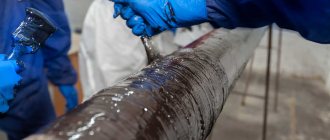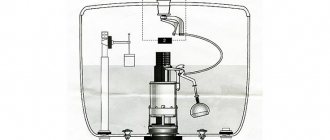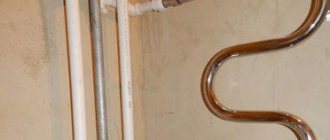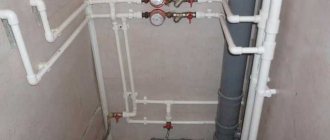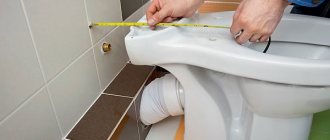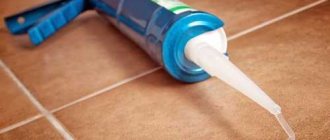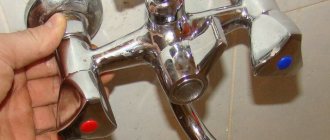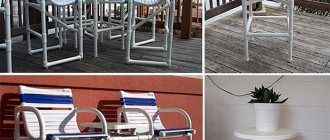Factors characterizing system depressurization
The heating system consists of the following main elements:
- heating boiler;
- pipeline;
- radiators;
- control and measuring and shut-off valves.
All of the listed elements are mounted in a heating circuit, the tightness of which depends on the integrity of the constituent elements and their connections.
The choice of method to restore the integrity of the heating system depends on the following factors:
- accessibility of the damage site;
- leak status (fistula, loss of tightness of a threaded connection, etc.);
- material of manufacture of the damaged element;
- availability of the ability to disable the system.
Based on the totality of the above circumstances, a method is selected to most effectively seal the leak in the heating pipe in the current situation.
Preparatory work
When spot repairing a heating system, it is first necessary to determine the specific location of the coolant leak. If the pipeline is laid hidden (in the wall, in the floor), lined with decorative elements or equipped with thermal insulation, the task becomes more complicated.
Important! In a situation where a pipe or joint embedded in a wall has leaked, it is advisable to consider the possibility of installing a new section of the pipeline, since it makes no sense to spoil the finish of the room to repair a pipe with a high degree of wear.
In the supposed emergency section of the circuit, decorative finishing and thermal insulation are dismantled, the location of the leak is found, after which the nature and extent of the damage, as well as its accessibility to repair, are assessed.
Spot repairs of the heating system can be of three types:
- mechanical - using crimping and tightening devices, electric welding and other means not based on the use of sealing solutions;
- chemical - using various types of sealing compounds that harden as a result of chemical reactions or drying;
- combined - sealing the circuit using a combination of mechanical and chemical methods.
If a mechanical repair method is chosen and the damage is not significant (needle fistula or drip leak), the heating system can be left in operating mode before starting work to eliminate the leak. If the damage is more serious, then the heating must be turned off:
- the autonomous boiler is turned off, the coolant is drained;
- in a central heating system, it is necessary to close the valve of the common riser and hang a warning sign on it, and then also drain the water from the system.
The technology for treating the base before sealing the circuit depends on the material of the pipeline, the status of the leak and the type of repair, but, in any case, the final result of the work is largely determined by the quality of surface preparation.
Elimination of leaks at pipe joints
Eliminating leaks at the joints of cast iron pipes using the caulking method
If a pipe is leaking, what should you do in cases where cast iron pipes are involved? If cast iron sewer pipes are poorly connected, then coping with the situation will be more difficult. It all depends on how their joints were sealed.
In cases where pipes are caulked with lead, perform the following steps:
- clean the joints until clean metal appears;
- caulk the gap with lead cones using a blunt chisel (lead easily seals the gap due to its softness).
If the pipes were sealed with cement, then proceed as follows:
- remove the remains of old cement using a narrow chisel and hammer;
- Having removed the old packing, clean the gap;
- hammer in new tarred strands and close the gap using cement mortar (1 part water to 10 parts cement).
Advice!
Before hammering the strands, it is recommended to treat them with a mixture prepared from 7 parts cement, 3 parts asbestos with the addition of water, until the consistency of plasticine is obtained.
Is there a leaking pipe in the bathroom? Re-caulk it
Seal a pipe joint leak with cement
When a pipe leaks, what should you do if it turns out that out of everything you need to eliminate the leak, you only have cement?
There is another way out of this situation:
- clean the pipe joints, remove the old seal (to avoid damage to the pipes, do not use heavy tools);
- prepare the materials necessary for work (wide gauze bandage, some cement);
- Having dissolved the cement in water until a slurry forms, dip a bandage in it;
- wrap the pipe joint evenly with a bandage pre-treated with cement mortar;
- after hardening (about 2 hours), clean the joint with sandpaper and paint over it.
Causes and locations of leaks
There are only two reasons for leaks. The first is mechanical damage. Everything is clear here, but the second reason is corrosion. The cause of corrosion in heating is poor water treatment. In central heating, water treatment equipment purifies water from mechanical impurities and salts. This is not the case in private houses and cottages.
The presence of salts and electricity leads to increased rust formation.
The places that rust the most are threaded connections, welds, and bends made by heating. Often the fistula appears in straight sections without welds or threads. Perhaps these are pipe defects or a pipe installed that is not intended for heating.
How to quickly fix a leak
Here are some methods for emergency pipeline repair. Each of them can eliminate the leak even if it is not possible to close the water supply to the system. This will allow you to save your home from flooding before specialists arrive.
If the water leak is caused by depressurization of the threaded connection of the pipeline with the distribution or shut-off valves, you can try to tighten it. There is no need to apply excessive force to avoid stripping the threads. If there is no positive effect, as soon as possible, reassemble this unit and replace the seals (tow, gaskets, FUM tape).
A leak in a straight section of pipe can be quickly eliminated using special metal clamps with a rubber seal. If there is no factory bandage at hand, then a homemade one is made. To make it, you can take, for example, an old bicycle tube or a boot top. A rectangle of suitable dimensions is cut out of rubber, which is tightly wrapped around the pipe and tightened with clamps or wire. It is important that at least one tie is located directly at the site of damage.
In addition to soft rubber, you can use mounting tape to make a bandage.
Despite its simplicity, repairing a leaking pipe cannot be carried out using this method if the water supply is located close to the wall.
It is quite possible to make reliable clamps of the required size yourself from a strip of sheet metal of suitable width by drilling holes for installing tie bolts along its edges.
You can also significantly slow down the flooding of your home until the water supply in the riser is cut off using wooden wedges. If the hole in the pipeline is small, just drive a regular toothpick into it. Such a wedge swells with water and is able to withstand pressure for some time until repair services arrive.
If the heating system pipes are slightly damaged, to temporarily stop the leak, try wiping the crack with a handful of salt. In the event of a significant pipeline leak, it will be more difficult. To urgently eliminate it, you can try to apply several turns of a bandage to the defective area, periodically sprinkling it with salt. In this way, it will only be possible to temporarily stop the leakage of water as long as it remains hot.
Required tools and materials
Depending on the method of repair, the set of tools and materials will change.
Let's try to unify:
- Set of welding equipment and electrodes. Welding repair.
- Box or open-end wrenches ranging in size from 8 to 24 mm. When installing bandages and clamps.
- Latex gloves.
- Pliers and knife.
- Annealed steel wire 1.5-2.2 mm.
Methods for eliminating leaks
When welding PPR pipes, the diameter is taken into account. This affects the choice of socket or socket welding. The connection is made using a coupling, and butt and threaded assemblies are made with fittings with a socket. If the pipe diameter is more than 63 mm, then butt welding is used. The connection is made with special equipment.
Socket soldering is performed with a welding machine if the diameter does not reach 40 mm, and if it exceeds, centering devices are selected. After degreasing, they proceed to the welding process. Soldering is responsible for reliability and high-quality connection.
To ensure that the sections are clearly attached, it is important to cut correctly, so use sharpened scissors. When installing heating systems, it is important to clean the edges of the product. Any repair by soldering is considered a relevant method for connecting components. The process can easily be done independently. They do not allow the structure to leak and give strength and durability.
Classification
This material can be single-sided or double-sided and can be used to work in different temperature conditions and with different materials. Before purchasing tape for specific jobs, read the instructions for use. Insulating tape for sealing water pipes comes in the following types: butylene, bitumen-polymer, roofing and polycarbonate.
Tapes of various classes can be used not only during construction and repair work, but also when working with vehicles, in the oil and gas industry, and is also used in domestic conditions. This material can be used both to eliminate leaks and when installing electrical networks to create a waterproof layer.
Joint sealing tapes
In cases where it is necessary to ensure a high-quality connection of a thread or flange, in addition to the use of surface tape, internal plumbing tape is used. It is thinner and has other technical and operational properties. Such sealants include the brands “K-Flex”, “FUM”, “Record”. There is also a special composition in the form of a gel, which allows for additional compaction and sealing of connections.
Thread sealers can be used to work with pipelines of various classes. They help eliminate leaks of natural and liquefied gas, drinking and industrial water, and various antifreezes. They are used by plumbers, gas workers and even car mechanics.
Thread sealing tape can be used in conjunction with surface insulation.
Butylene
This type of sealant can work in a wide range of temperatures - from -60 to +120 degrees Celsius. Butylene tape is suitable for repairing leaks in water pipes and when working with gas pipes. It consists of a butyl rubber mixture, so it has excellent contact with almost any material. It can also be used when working with polyvinyl chlorides. Butylene is able to withstand exposure to ultraviolet radiation, acids, alkalis and does not emit any odor.
Bitumen-polymer
An airtight material that can be used to seal imperfect, rough and uneven surfaces. This material not only provides high-quality sealing of seams and pipeline connections, but is also capable of sealing itself in case of damage. This feature allows the tape to be used to provide dielectric and anti-corrosion protection. It is also suitable for connecting joints, including connectors with flange and thread.
Fum tape
Explanation of the abbreviation FUM - Fluoroplastic Sealing Material. The most popular type of sealant for improving the sealing of water and gas pipes. Used inside threads, sometimes applied over joints. This pipe tape is distributed in the form of rolls of white color, resembling electrical tape, 1-2 centimeters wide. Fumka or fum tape is divided into several categories, depending on the technical characteristics and composition:
- for use in aggressive environments – withstands and withstands the effects of acid, alkali, natural and liquefied gas;
- for oxygen - since this gas leads to rapid corrosion, innovative compounds are used to seal oxygen-conducting pipelines that can withstand the aggressive environment of this chemical element;
- for domestic needs - withstands aggressive environments, which are not uncommon in a private home, produced for domestic use.
Solution
The problem can be solved like this:
- If the radiator begins to leak, you should close the shut-off valves at the outlet and inlet of the device. If the radiator has a bypass, then the system can continue to operate without interruptions, but if it does not, then it is better to simply turn off the heating boiler to avoid unexpected overheating of the heating system.
- If you do not have shut-off valves or they are installed, but not where required, then the heating should be stopped so that the pipes are not under pressure, and then proceed to eliminate the leak.
Steel pipes containing hot water begin to rust quickly even if they are completely painted and this can cause thinning of the pipe walls. But in the thinnest places, a leak may appear over time, and if it is not eliminated in time, then the drops will imperceptibly turn into a good stream. If colored spots appear on the surface of the pipe, then the paint begins to swell, traces of streaks of rusty water or rust on the pipe are visible, water begins to drip imperceptibly, and then you should not wait and hope that this will go away on its own. It is better if you find this in the summer when the heating is turned off - in this case there will be fewer problems with turning it off and maintaining the temperature inside the room during repair work.
How to fix a leak in a pressure pipe (with water)
Let's consider popular methods:
If pipes begin to leak when the coolant pressure is low, then a standard iron pipe clamp will be the right and quick solution to eliminate leaks in the heating system when eliminating the leak. The factory clamp is a round structure made of metal, and has a wall thickness of 0.01 to 0.015 cm, is rubberized on the inside and has a bolt with a nut for tightening (or a pair - everything will depend on the width of the clamp).- The popular recommendation for how to fix a leak if there is no steel clamp available is to wrap the accident site with rubber from a bicycle inner tube, a rubber bandage from a first aid kit, or any other suitable piece of rubber, for example, even the most ordinary rubber glove. Attach such a homemade clamp with wire, or wrap it with any kind of cord.
- If you don’t have a factory clamp or rubber, you can make your own clamp from tin, even if it’s tin in the form of a can lid.
- Even a piece of elastic polymer (for example, volcanic rubber), which will be tightly wrapped with wire, turn to turn, will help save the situation (albeit temporarily, until the technician arrives).
Other methods for eliminating an accident if a heating pipe is leaking will not be suitable - using cold welding, only dry surfaces are allowed to be sealed, although the hardened composite can even work under water. It will not be possible to seal a gap or hole using a sealing compound for a similar reason - the surface to be repaired must be dry, and ideally also clean. For this reason, pipe sealant, epoxy resin, dichloroethane and other fast-hardening composites are used only on dry and disconnected sections of the heating route. This refers to the repair of the water supply line in a hot or cold water supply pipe.
How to fix leaks in your home heating system
So, you need to fix a pressure pipe leak. If the leakage is severe and it cannot be stopped using a conventional clamp, then you will need to turn off the heating circuit with liquid. It doesn’t matter where you find the leak - on the heating pipe or on the water supply line, eliminating the leak will be possible if you turn off the water supply. A disconnected circuit is not difficult to carry out repair work - at the same time you can check the entire route, as well as repair or at least replace all areas that seem suspicious to you. So, let's start with the easiest ways to fix a leak in a heating pipe.
Seal the gap or hole with a fabric (or fiberglass) patch, which will be liberally coated with epoxy glue. Cut the patches (and there should be at least a couple of them) a couple of times wider than the diameter of the pipe, and the length should make it possible to wrap the pipe at least 6 times. The metal around the site of the violation should be cleaned using sandpaper, a fingertip or a grinder, and the area should be thoroughly dried, then epoxy resin should be applied to it.
The fabric should be soaked with glue in advance, or it can be coated as it is wound onto the pipe - this is whatever is more convenient for you. Do not soak the last layer of fabric with glue, and the end of the fabric should be secured with wire or cord. The epoxy will dry on the pipe, and the time it takes is always different - at a temperature of 20 to 25 degrees, a few hours will be enough, and if the ambient temperature is less than +18 degrees, then even a day will not be enough.
If you are repairing a central heating pipe, the system will operate under higher pressure than with individual heating, and during the initial water supply after repair work, a strong water hammer can occur in the circuit, which can even rip off the patch. For this reason, the supply valve must be opened very slowly, carefully, and visually monitor the area with the patch.
To increase the strength of the installed patch, you can add bronze or aluminum powder to the epoxy glue. If you can’t buy powder, you can make it at home with your own hands, and for this you just need to grind off the surface of a part made of non-ferrous metal with a small file or needle file. By adding such powder, you can make not 6 turns of fabric, but only 3, and in addition, repairing such an area will become much easier.
Factory materials
From ready-made adhesives, solutions and liquids, you can use a product such as a heat-resistant waterproof sealant that will help seal the leak. Such adhesive compositions are made specifically for repairing heating systems. When purchasing, make sure that the label contains the word “neutral” - this will mean that the glue will not corrode the non-ferrous metal and materials that are attached to it.
Also, in order to eliminate leaks in a heating pipe under pressure, cold welding is perfect:
- Liquid epoxy substance, which will be convenient for impregnating fabric patches, should be applied to the hole in the pipe. Some compositions can act even on a wet surface.
- Semi-solid plastic compositions. Such cold welding looks like a small piece of plasticine, which consists of two different-component strips. The plasticine should be kneaded in your hands until a plastic substance appears (your palms must be wet, so moisten them in water), and then cover the pipe hole with a small piece and spread it over the cleaned surface. 15 minutes will be enough for hardening, and after that the patch will become so hard that even a good file will practically not be able to take it.
But keep in mind that both solid and liquid welding contain toxins, so it is recommended to work with it only with rubber gloves.
Sealing connections on pipes and between sections in the radiator
If connections at the joints of fittings or pipes begin to leak, then, depending on the diameter of the leak, you can seal the pipeline using a metal clamp or, at the place where the diameter is smaller, first wind up rubber. The rubber band can be easily wound even under high pressure and stop severe leakage. To seal a threaded connection in the place where tow or FUM tape is wound, BF-2 glue will help perfectly. To use the tow should be soaked in advance with alcohol and then coated with glue. The dissolved alcohol glue will begin to saturate the winding, and after drying it will create a dense waterproof layer.
What other substances can be used to impregnate the winding and how to wrap the pipe so that it does not pierce? Most often, standard oil paint is used (in no case nitro!). To do this, wrap the tow around the thread, apply paint with a brush, and then tighten the thread of the area and paint a couple more times. After such treatment, heating or plumbing can be turned on after 48-72 hours.
If you can’t seal the leak with your own hands, then you will need to turn off the water supply or heating and redo the connection point on the thread - remove the old winding completely, clean the thread and degrease it. New FUM tape or tow should be wrapped with preliminary impregnation with sealant or oil paint.
- When a metal-plastic fitting leaks, it is even easier to eliminate a leak in the water supply network - you can stop the leak if you simply tighten the thread. In 9 out of 10 cases this helps.
- In order to stop the leak, the copper circuit will only need to be soldered and nothing else.
- Repair pipes made of propylene on the heating circuit and replace the cracked section with a new piece of pipe - this will require a special welding machine for welding polypropylene products, since there is no longer a way to weld propylene.
If you don’t know what to do if there is a leak between the sections of the battery, then the most common repair is to replace the gasket between the parts of the radiator, or replace the nipple. To do this, you will need to turn off the system and replace the part that has failed. There are no other options other than to make a temporary repair - simply apply a patch using the method described above. This is a rather complicated process in itself, since with aluminum radiators the distance from one section to another is quite small.
To be able to eliminate a leak in a floor pipe using pressure on an aluminum surface, and even between sections, you need to get smart and somehow clean all the hard-to-reach places. To do this, you can use a cable - it should be wrapped around the leak, and then pulled at the ends one by one until all the paint is erased. A clean aluminum surface must be sealed with epoxy resin mixed with aluminum powder, or everything must be sealed using the cold welding method.
By the way, few people know about this, but you can seal a heating pipe with regular table salt! A small hole in a water pipe or heating line will immediately stop leaking if you rub it with a pinch of salt. If the hole is large, then use salt with a bandage - rewind the leak, sprinkle the bandage with salt.
Please note that if an aluminum radiator leaks, the repair will only serve as a temporary measure for one season. In order to live normally next winter, you will need to replace the radiator, since otherwise it will leak, but in a different weak point.
How to fix a radiator leak
Not on the threads, not between sections, but only on the body of the radiator - such cases occur mainly with steel or cast iron pipes due to cavities that get into the casting.
You can perform temporary repairs like this:
The easiest and fastest way to stop a leak (especially if the hole is small) is to hammer a wood plug (i.e., a plug) into it. Level it with the surface of the product, seal it with sealant or cold welding.- In addition to wood, a press washer or self-tapping screw can work great. The hardware will also need to be lubricated with sealant before screwing it into the hole.
And let's look at how to solve the last problem.
Hidden pipe leaks
Naturally, the biggest nuisance you can imagine in a newly renovated apartment will be a hidden pipe leak.
There are two ways to cover the hole so that the pipe under the floor or in the wall does not leak:
- If we are talking about a heating circuit, then add 100 grams of dry mustard to the expansion tank. Wait 2-3 hours for small holes to heal. The next day, the mustard water should be poured out of the system, and then clean water should be added. This is required to ensure that the filters in the heating circuit do not become clogged.
- Mustard is a household folk way to solve the problem, but it works the same way as a sealant that needs to be poured into the thermal fluid so that the pipe does not leak. The principle is similar - the next day the liquid should be drained and replaced with clean one.
Please note that mustard can only be used for water, and factory solutions can be used for both antifreeze and water.
Mechanical methods of pipeline repair
These methods are quite numerous, since craftsmen successfully use various available materials.
Medical bandage and cement
This is the simplest option if the “appearance” of the pipe is not nearly as important as its tightness. In this case, the operation consists of simple steps:
- first the bandage is cut into pieces, then a not too thick cement mortar is made;
- strips of material are thoroughly impregnated with the mixture, after which they are quickly wound around the damaged area.
The resulting cocoon is again coated with the solution, then left to dry. Such an almost “concrete structure” dries out in about a day. The finished patch is painted.
Help with self-tapping screws and bolts for metal products
This is another popular option when considering repairing water pipes without welding. It is suitable if the thickness of the metal walls is more than 3 mm, and the diameter of the hole that appears is no more than the same 3 mm (maximum 4 mm). The role of the “plug” is played by ordinary galvanized self-tapping screws, supplemented with a rubber washer. The operation is quite simple:
- The sections of the pipe near the hole are cleaned of rust with a file or sandpaper.
- Then a self-tapping screw is screwed into it. To facilitate the operation, use a screwdriver.
It is better to use a cordless tool. The fasteners must be selected so that the part of the self-tapping screw inside the water supply is minimal. It is clear that such repairs are still a temporary measure. To get more reliable protection, it is recommended to use a bolt. In this case, the procedure is different. First, a thread is made into the hole with several self-tapping screws, then a bolt, also equipped with a rubber washer, is screwed into it.
Some craftsmen believe that it is not always advisable to screw in bolts, especially if the case is an emergency. When the age of the pipe allows, the element can simply be driven in, but the hammer must be used carefully.
Using a rubberized metal clamp
This method is also used if the hole in the pipe is relatively small. A metal clamp is chosen with the same diameter as that of the damaged water supply section. If several leaks occur in one area, it is recommended to purchase a device of greater width.
The rubber gasket on it is a mandatory element, so it is better to immediately purchase just such a product. However, the seal can be made independently from a rubberized material whose thickness is at least 3 mm. The recommended width of a homemade gasket is 2-4 mm larger than that of a clamp. Length - 10 mm less than the circumference of the pipeline.
Using a temporary bandage
Such repair of water pipes without welding may be necessary if an emergency occurs at an inconvenient time, when it is not possible to do a quality job. This will help temporarily eliminate holes that are oblong in shape. In this case, first look for a suitable material for the bandage. It could be:
- bicycle tire;
- boot top;
- medical tourniquet;
- thick glove.
The main condition is that the size of the material is sufficiently large: it must completely block the flow. Such “temporary structures” are fixed with bolts and clamps.
Magnet for small leaks on metal
This method is quite original, but it is said that it still works if the hole diameter does not exceed 1 mm.
- The leaky area is processed with a file until smooth.
- Then a magnet is attached to it.
The method uses the properties of a magnet to collect metal particles present in tap water. As a result of its “attractiveness,” a metal plug is collected near the hole, which can reliably close the hole.
How to repair a fistula - traditional methods
There are several proven ways to eliminate a leak in a radiator or heating pipeline using home remedies:
- use of a magnet and self-tapping screw;
- applying a saline or epoxy “compress”;
- adding mustard powder;
- making homemade heat-resistant sealant.
Please note that we are not talking about the most common option - a bolt-on clamp. This remedy is familiar even to housewives, but with the advent of plastic pipes it is not always applicable. The idea is simple: a strip of thin metal is cut along the circumference of the riser, and holes are drilled at the ends. The fistula is sealed with a rubber gasket, tightened with bandage bolts.
If the battery is connected correctly, it can be easily disconnected from the riser and repaired
Also, you should not reinvent the wheel when a leaking heating battery is connected according to the correct circuit - with a bypass, ball valve and balancing valve. Shut off the fittings, calmly remove the heating device and eliminate the leak. If the radiator is connected directly, without shut-off valves, choose the appropriate repair method locally.
Magnet and self-tapping screw
Metal particles travel along the communications with the coolant, especially in systems made of steel pipes. If a small crack appears or a connection leaks, these particles can be used as a sealant. Without draining the water, a small magnet is applied to the pipeline, attracting the metal to the defect point. Practice shows that after 1-2 days the leak is delayed.
Recommendation. The method works well on aluminum and bimetallic radiators; you just need to attach a magnet. This method is not suitable for large damage and plastic pipes.
When the connection is dug, a piece of magnet from an old speaker is applied to it.
The option with a screw is simple to implement: select a self-tapping screw of the required diameter and screw it into the hole. The method helps in such cases:
- for point defects measuring 1.5-5 mm;
- on pipes made of copper, polypropylene (PPR) and cross-linked polyethylene;
- on bimetallic and aluminum radiators.
Note. Damaged metal-plastic pipelines are prone to delamination, so a self-tapping screw plug will not help.
To be sure, the screw being screwed in can be coated with automotive silicone sealant or epoxy resin. If the hole in the pipe is quite large, instead of a self-tapping screw, drive a wooden peg into it, sharpened to a cone. Cut the top of the plug flush with the surface and apply a regular clamp.
Salt “bandage”
The essence of the technique is to create conditions for artificial corrosion of metal. Therefore, we recommend using this method on old steel pipe systems that are planned to be replaced in the near future. The size of the hole or crack is 1-2 mm.
How to seal a leak:
- Wet a medical bandage and make 1-2 turns around the pipeline at the leak point.
- Sprinkle the bandage with table salt and continue wrapping. A total of 20-40 layers will be required.
- Wait 2-3 hours and start heating. At first, coolant leakage is possible, but after a day the leak will completely heal.
Clarification. There is no need to clean the steel pipe before winding. If necessary, work is carried out under pressure, if the temperature allows.
Salt is not suitable for sealing polyethylene and polypropylene pipes. Home craftsmen advise on the Internet to impregnate the bandage with the following compounds:
- liquid glass;
- automotive high temperature sealant;
- epoxy resin based adhesive.
We do not share the point of view of these craftsmen, since the listed substances do not have good adhesion to plastic. Here you will need special chemical compounds discussed below.
Homemade sealing compounds
A repeatedly tested sealant for heating pipes – dry mustard. When mixed with coolant, it perfectly seals small leaks that occur in mains, pipeline fittings, batteries and even boilers. The application technology looks like this:
- Buy 100-200 grams of mustard powder. The amount depends on the volume of water in the heating network.
- In an open type system, pour mustard through the expansion tank. Set the boiler to 60-70 degrees.
- With a closed circuit, the powder must be mixed with water and pumped through the make-up tap.
A 200 gram pack of mustard powder is enough to tighten small leaks.
The fine mustard fraction is highly hygroscopic (the ability to absorb moisture). Once in the water, the microparticles swell, take on an irregular shape and get caught on internal irregularities, sealing all the leaks from the inside. Including at joints and in hard-to-reach places.
An important nuance. It is unacceptable to add mustard to a non-freezing coolant - ethylene glycol or propylene glycol.
Mustard powder is harmless to boilers and does not cause corrosion. To eliminate leaks in batteries or heat exchangers, the dose will have to be increased. Sealing takes from several hours to 2 days.
Sometimes, for external sealing of heating or water supply lines, plumbers use a mixture of cement (alabaster) with PVA glue without adding water. The components are mixed until a thick substance is obtained and quickly applied to the injury using the same bandage. Before fixing a radiator or pipe leak with an improvised sealant, wipe the surface dry; it is better to remove rust and paint.
Methods for eliminating leaks in a straight heating pipe
A local leak of a metal pipe in its straight section (fistula) is the easiest option for self-remediation. There are several ways to deal with the problem without draining the water.
Mechanical method for eliminating leaks
The classic way to seal a leak is to install a crimping device on a rubber gasket while the heating system is running.
The methods are as follows:
- The damaged section of the pipe is wrapped in soft rubber (for example, a bicycle inner tube). Secure the patch with metal wire, tightening it well in several turns along the length of the rubber.
- The rubber patch is secured with two narrow crimp clamps of the appropriate diameter.
- If there are several leaks, they are localized in close proximity to each other, then you can seal the leak in the heating pipe by installing a metal clip. This is a wide clamp with a built-in rubber gasket that tightens in two places.
Note! In this way, the leak is sealed temporarily, eliminating the problem for the period until a repair specialist is called or until the end of the heating season.
If the fistula has formed in a thick-walled pipe, then it can be repaired by installing a special self-tapping screw with a rubber seal in front of the cap. To do this, clean the leak area and screw in a self-tapping screw using a hand drill.
Note! You can use an electric drill only if there is no coolant in the system. Otherwise, you risk getting electrocuted if water comes out of the pipe.
Chemical methods for eliminating leaks
Manufacturers of repair sealants offer a lot of materials for sealing leaks in heating systems with metal or polypropylene pipes.
We recommend reading: Three proven ways to get rid of blockages using baking soda and vinegar
From available means, you can use automotive sealants for high-temperature operating conditions. The fabric is impregnated with this composition and the pipe is wrapped where the damaged area of the heating circuit is found.
This method of eliminating leaks is used not only in straight sections, but also in places of threaded connections or joining pipes of different diameters. This is justified if it is impossible to turn off the heating at the time of repairing the joint.
To seal leaks in heating pipes, the following chemically active substances are used:
- Two-component sealing resins based on epoxy.
- Adhesive silicone mixtures that quickly “set” (cold welding).
- Heat-resistant mixtures based on rubber.
Note! It is possible to seal a leak in a heating pipe using chemical sealants only when the heating is turned off and the system is empty.
The algorithm of actions is as follows:
- The damaged section of the pipe is degreased, dried and a thin layer of sealant is applied to it.
- Wrap the repaired area with a special fiberglass tape. It serves as a reinforcing element in the mass of hermetic coating.
- The chemical composition is again applied to the serpyanka. The action is repeated.
As a result, a sealing layer is formed on the pipe body, which reliably protects it from leaks.
Note! Silicone sealant adheres to a smooth surface much better than to a rough one. Contrary to habit and popular belief, the damaged section of the pipe should not be sanded with abrasives (for example, sanded with sandpaper).
Fixing a leak in a heating pipe
A leak in a heating pipe can occur for several reasons:
- The pipes are not tightly connected.
- Rust through.
- Formation of a crack on the surface of the pipeline.
To eliminate such problems in heating pipes, several options are used to get rid of the leak: use glue, cold welding, or install a clamp.
If through rust has formed in the pipe, then cold welding or an adhesive mixture is unlikely to help. In this case, you will have to replace the corroded section with a new pipe.
Preparing the “stub”
Electrode welding is not often used when repairing a crack in a heating pipe. And in winter it is difficult to do this. You might suggest using a so-called “stub”. To prepare it, take a piece of old material, impregnate it with sealant, and then wrap it around the required area.
Before attaching the “plug”, water should be drained from the heating system. Dry the leaking section of the pipe, clean it from dirt and dust. Only after careful preparation can you begin to repair the crack.
You can use old burlap or a medical bandage as material for the “plug”. For the adhesive base, use liquid glass or a silicone hermetic mixture used in construction.
Repairing the crack is simple. First of all, soak the material in the hermetic mixture. Use a brush to brush over the surface of the heating pipe. Wrap the pipe with a cloth soaked in sealant and leave the composition to harden for a while.
If the crack or hole is small, then you can use plasticine sealant. In order for it to tightly close the leak, the composition must be mixed with a hardener. Apply the product to a dry and thoroughly cleaned surface of the pipeline. Once the sealant cures well, it will become rock hard.
It may be interesting: Advantages and disadvantages of separate and combined bathrooms
Sealing leaks at joints
You can seal leaks at the connection points of the heating circuit in the following ways:
- Install a classic crimp clamp, first eliminating any unevenness with additional rubber bands.
- Seal the leak at the joint by wrapping it with several layers of soaked elastic fabric. As impregnation, you can use waterproof adhesives or ordinary nitro enamel.
- Minor damage can be repaired using baking soda and instant glue. Lightly moistened baking soda is rubbed into the gap or fistula until it fills the entire space. Super glue is poured on top. The substances instantly react with each other, forming a strong plug.
It is convenient, just in case, to have a ready-made kit at home for local repairs such as Siloplast. The kit includes an acrylic fistula pad and a tape impregnated with a special compound for sealing the leak. It is enough to wrap it around the pipe and moisten it with water. For such repairs it is not necessary to drain the water from the heating system.
Note! High-quality repair of threaded connections requires mandatory dismantling and diagnostics.
Causes and localization of leaks in the heating system
Leaks in the heating system occur for various reasons and in different places in the circuit: in straight sections or at pipe joints.
Leaks on straight sections
The cause of leaks in metal heating pipes that have been in use for more than one year in more than 95% of cases is corrosion (rusting) of the metal.
Even thick-walled galvanized pipes in heating circuits are eaten away by rust over time. The destruction of metal upon contact with water is a natural process that has not yet been completely overcome.
The trigger for metal destruction can be:
- mechanical, chemical internal damage to the pipe;
- changes in temperature or pressure;
- damage to the protective outer layer.
Note! If a leak occurs in an old heating pipe, then most likely this is a warning about total wear and tear of the entire system.
In autonomous heating systems, which are installed from modern polymer materials, leaks are caused by the wrong choice of pipes.
When the owner, out of ignorance or for reasons of saving money, purchases pipes for cold water or pipes not intended for use under pressure for hot water supply systems or a heating system. In this case, simply sealing the leak is not enough; often a complete replacement of communications is required.
Leaks at connections
Leaks in the connection area occur if the thread has become unusable (for example, it has become stuck and was torn off).
We recommend that you familiarize yourself with: Features of a sandwich pipe and rules for its installation when constructing a chimney
If there is a leak at the fitting installation sites, the prognosis for effective local repair is more favorable. Here you can fix a leak in the heating system by replacing a worn gasket that has lost its elasticity.
In more serious cases, it may be necessary to replace the connecting (adjustable) fitting or valve.
How to eliminate a leak in a pipe: malfunctions of systems and products made of various materials
Depending on the location of the damage and the material from which the system or its individual parts are made, there are also the following ways to eliminate them:
Seal a leak in the heating battery (radiator)
- The main battery malfunctions are divided into the following types: formation of cracks in the case. Such damage can be repaired using cold welding (an adhesive consisting of two components prepared on the basis of epoxy resin). This glue is highly resistant to high temperatures and humidity. Before starting to apply it, you must turn off the system from the water supply and clean the surface using sandpaper or a file.
- the malfunction is caused by poor sealing of the seams between the individual sections. In most cases, to solve the problem, you will have to replace the entire radiator, or a separate section of it (for multi-section collapsible batteries). But to urgently repair the damage, you can use the following method. Available tools will require alabaster, cement, water, medical bandage or gauze. Alabaster, cement and water are mixed in any container until thick. Then strips of bandage or gauze are dipped into the resulting mixture and applied to the damage in several layers (from 2). The radiator can be used only after the pad has completely dried.
- The leak occurs at the junction of the radiator and the pipeline. This problem is most often caused by poor installation of the product. During battery operation, the vulnerable spot is subjected to heavy load and, as a result, a leak occurs. Such a malfunction can be eliminated using a rubber gasket and a clamp (or regular wire). The gasket can be made from a piece of a car inner tube. The overlay is cut out with a “spare” and wrapped around the damaged area. Then it is tightened with a clamp or wire (using pliers).
How to fix a leak in a plastic pipe
- To eliminate leaks on polymer pipes, there are methods similar to methods for eliminating leaks on products made from other materials: a common way to eliminate damage on a straight section of a pipe is to apply a rubber band or a similar “tightening” material. Such a gasket is attached to the pipe using metal clamps (which may already contain a rubber gasket), plastic ties or wire.
- Very small cracks and leaks in a straight section can be solved by wrapping regular electrical tape in 4-5 layers. It is important to take into account that each subsequent turn should overlap the previous one by 2-3 mm.
- Also, a very small leak (droplet type) can be solved by applying oil paint to a previously cleaned and degreased surface. It is worth remembering that this method will most likely eliminate the problem for a short period of time, and in the future it will make itself felt.
- Various chemical compounds can help eliminate leaks on straight sections of plastic pipes, bends and joints. These can be various sealants, cold welding (epoxy-based glue), silicone-based adhesives. The main rule that must be followed is that the composition must be applied to a completely dry, cleaned (using a file or sandpaper) and degreased (acetone and other solvents) surface. When using chemically active substances, you should wear gloves and carefully read the instructions for their use.
How to fix a leak in a cast iron pipe
- To troubleshoot straight sections of cast iron pipes and at their joints, the following methods are usually used: for the work you will need a cement mortar (10:1 - 10 parts cement to 1 part water), a bandage or gauze. The first step is to clean the damaged area with a file or grinder. Then a bandage is dipped into the prepared cement solution and wrapped around the damaged area in 3-4 layers. Next, the remaining thick cement mixture is either compacted into the joint between the pipes (in case of damage at the pipe connection), or smeared over the surface of a bandage or gauze (in case of damage in a straight section)
- A good emergency solution would be to apply a rubber gasket to the fault and secure it with metal clamps.
How to repair a leak in a pipe: mechanical methods
There are various methods using available materials to close the damage in the pipe.
Seal a leak in a metal pipe using a self-tapping screw.
In the event that on a metal pipe with a wall thickness of more than 3 mm. a small “drip” type hole with a diameter of up to 3 mm was formed. You can use a regular self-tapping screw with a rubber washer:
- The surface around the damage should be cleaned of rust deposits using a file.
- Then a self-tapping screw with a rubber washer is screwed into the hole, ensuring that the protruding part of the self-tapping screw inside the pipe is minimal. To carry out the work, it is better to use a screwdriver or electric drill.
In order to avoid damage to the tool, you should use a screwdriver with a built-in battery, wrapped in polyethylene.
Seal a leak with a diameter of more than 3 mm in a metal pipe.
If such a problem occurs, the danger of an emergency situation increases and most likely a screwed-in screw will help, but not for a long time, but you can try screwing several screws into one hole. In this situation, it is better to use a bolt, having first made a thread for it in the resulting hole. As in the previous case, there should be a rubberized washer on the bolt, and its protrusion above the inner surface of the pipe is minimal.
Seal a leak in a pipe made of metal or polymers using a rubberized metal clamp.
If small diameter damage occurs, you can use a regular metal clamp.
The clamp is selected to match the diameter of the damaged pipe.
There must be a rubber gasket on the clamp. If it is not available, it can be made from an ordinary piece of any rubberized fabric with a thickness of at least 3 mm.
In a situation where there are several leaks located close to each other on a straight section of the pipe, it is more effective to use a wide clamp.
How to seal a leak in a metal pipe or battery using a magnet.
This method is suitable for small diameter damage (about 1 mm) on a metal pipe:
- The surface around the damage is cleaned with a file or grinder.
- A small magnet is applied to the hole
The essence of the method lies in the ability of a magnet to attract metal particles contained in a liquid flowing through a pipeline. These can be various impurities, sediments and other suspended metal particles. During the action of the magnet, a “plug” appears, plugging the resulting damage.
Connection of metal-plastic heating pipes
For metal-plastic pipes, similar connection methods can be used, with the exception of threaded ones. Since their operating principle was described above, there is no point in repeating them.
Installation of compression fitting for metal-plastic pipes
A fundamentally new connection option is represented by press fittings. They are divided into crimp and press-on or slide-on.
Compression press fittings
The sleeve that compresses the pipe can be fixed directly to the body or located separately. This type of work is performed using special pliers. The tool has a removable head, which is selected based on the diameter of the sleeve.
Scheme of crimp press fitting
Heating installation without welding pipes by crimping a press fitting is performed as follows:
- Cut the pipe using a pipe cutter.
- Clean the cut area.
- Use a gauge to eliminate ovality that occurs after cutting with a tool.
- Place the crimp ring.
- Place a dielectric gasket and an O-ring on the fitting, then press the element into the internal cavity of the pipe.
- Perform crimping using pliers.
If the work is done correctly, two stripes will be clearly visible on the inside of the sleeve where compression has occurred. These zones should not coincide with the locations of the sealing gaskets, otherwise they will be destroyed over time, which will significantly reduce the service life of the connection (5-10 years instead of 20-30).
Slide fitting
The difference between this connection option is that the ring is not compressed, but pulled onto the pipe. To do the job you will need a special press, not pliers.
Slide fitting
Connection instructions:
- Cut the pipe and put a metal ring on it.
- Expand the end of the part using an expander.
- Insert the fitting as far as it will go.
- Push the coupling using the press jaws and press it onto the fitting.
Attention! Such a connection is maintenance-free, so if a leak occurs or there is a need to change the design, you will have to cut off part of it along with the fitting and completely replace the element.
You can see how the sliding fitting is installed in this video:
Reasons for leaks
A common problem with plastic pipelines is the lack of tightness in the places where the sections were connected. There are several explanations why plastic pipes leak at the junction. This largely depends on the method of laying them, the type of fittings, and the qualifications of the technician.
The main causes of leaks are:
- Incorrectly selected temperature conditions for soldering plastic water pipes. This violation contributes to the destruction of the integrity of the connection at the junction of the pipe into the fitting and back. As a result, a leak forms. During the repair process, it is necessary to cut out the entire assembly and reassemble the connection from new parts. The use of sealant in this case is pointless.
- Loosening the clamp nut. It will not be difficult to deal with the leak (you need to tighten it), but only if the internal gasket and the fitting itself are intact. It will not be possible to cover the nut with sealant - if it has burst, it should be replaced with a new product.
- Poorly pressed compression fitting. It can be sold complete with a pipe. If such a joint begins to leak, then pressing in a new connecting type fitting will be required. Manufacturers of these parts do not recommend using pliers to repeatedly crimp the same shrink ring.
- Pipe not properly prepared. The joint of pipeline sections made by using push-on fittings will leak when the cut on the product was not smooth.
- The joint of plastic pipes leaks if it is made using an incorrectly selected adhesive joint or the time interval after completion of installation is not maintained - the glue has not dried, which means the surface has not had time to polymerize to a state of complete tightness. You need to select high-quality glue for plastic pipes for water supply and repeat the connection.
Common mistakes
You can’t skimp on clamps and install narrow ones. Remember, the clamp should cover the pipe with a margin of 2-3 cm on each side of the fistula, because on the inside the damage can be much greater.
Do not grab the pipe wrench and do not try to tighten the “current” threads; on old pipes, break them off.
You can’t work with an angle grinder and clean out fistulas; you’ll rupture them and get a flood. In general, power tools and water are a very dangerous pair. Do not try to fix a leak in a pressurized system, especially in apartment buildings, with anything other than a clamp or bandage.
The most common mistake is underestimating the situation, excessive self-confidence and haste. Most men can do everything else.
Be careful and careful.
In conclusion, let us remind you once again that all the repairs listed above are a temporary solution to the problem. Necessary in order to survive until the end of the heating season and begin repairs with the replacement of pipes and worn-out appliances. Repairers say “a small fistula is a harbinger of a big repair”
When is the best time to repair heating pipes?
During the inspection we saw that the heating pipe was leaking, what should we do? Once some confusion passes, the answer will become obvious - fix the leaks immediately. But how and when to start a thorough renovation? Of course in the summer. When it’s warm and you can safely stop the heating and drain the water.
But you shouldn’t delay fixing leaks. If it really breaks through, the damage will be significant. It is necessary to temporarily repair the damage and begin repairs after the end of the heating season.
In modern systems that are designed and installed in houses, it is possible to completely turn off one or several branches, without stopping the boiler or riser. In this case, you can carry out repairs without waiting for the end of the heating season.
